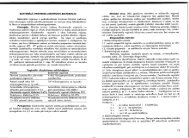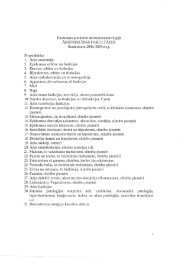PHYSICS
n - susliks.lv
n - susliks.lv
- No tags were found...
You also want an ePaper? Increase the reach of your titles
YUMPU automatically turns print PDFs into web optimized ePapers that Google loves.
x x x x x<br />
p -,<br />
x x x X<br />
B x\<br />
\ x x x<br />
x x<br />
Fig. 18.3. A mass spectro<br />
X '~ X X X X x: , x x x<br />
meter which consists of<br />
llHHI<br />
x x x x x x,/ x x x<br />
E-r - --- --- _....<br />
a velocity selector and<br />
xV x x x x x x<br />
a source of uniform<br />
XXXXXXXlxxxxx<br />
magnetic field<br />
Velosity selector<br />
x x x x x<br />
Bo, in<br />
Therefore, one can determine m/q by measuring the radius of<br />
curvature and knowing the field B.<br />
Example. A proton is moving in a circular orbit of radius 14 em in a<br />
uniform magnetic field of magnitude 0.35 T directed perpendicular to<br />
the velocity of the proton. Find the orbital speed of the proton.<br />
Solution. From Equation (18.3), we get<br />
V = qBr = (1.6 ·lO'19)(0.35T)(l4 ·10'2 m) = 4.69 . 10 6 m / s<br />
m<br />
1.67 . 10'27 kg<br />
18.3. AMPERE'S LAW<br />
Let us consider a straight segment of wire of length I, carrying<br />
a current I in an uniform external magnetic field (ii) (fig. 18.4).<br />
The total magnetic force on the wire is<br />
dF = I [dT x B] (18.5)<br />
where dT is a vector in the direction of the current I. Thus the<br />
force on a differential length dl of<br />
current carrying wire is the vector cross<br />
product of dT and the magnetic field fJ<br />
at dT.<br />
18.4. MAGNETIC FIELD OF A THIN STRAIGHT CONDUCTOR<br />
Consider the case of an infinitely long straight wire. The total<br />
magnetic field at the point located at a distance a from the wire is<br />
given as:<br />
B = flof<br />
(18.6)<br />
2na<br />
Example. Calculate the magnetic field of a long, straight wire carrying<br />
a current of 5 A, at a distance of 4 cm from the wire.<br />
Solution. From equation (18.6), we get:<br />
B = Jiol = 4n ·10'7 N / ~ 2 ·5A = 2.5' 1O-5T.<br />
Zna 2n . 4 . 10" m<br />
18.5. FARADAY'S LAW<br />
Let us consider a loop of wire connected to a galvanometer; if a<br />
magnet is moved toward or away from the loop, galvanometer<br />
deflects. It means that a current is set in the circuit as long as<br />
there is relative motion between the magnet and the loop. Such a<br />
current is produced by an induced electromotive force (E.M.F.)<br />
in a loop. The E.M.F. induced in a circuit is directly proportional to<br />
the time rate of change of magnetic flux (if]M) through the circuit.<br />
This statement is known as Faraday's Law of Induction:<br />
E = _ d






